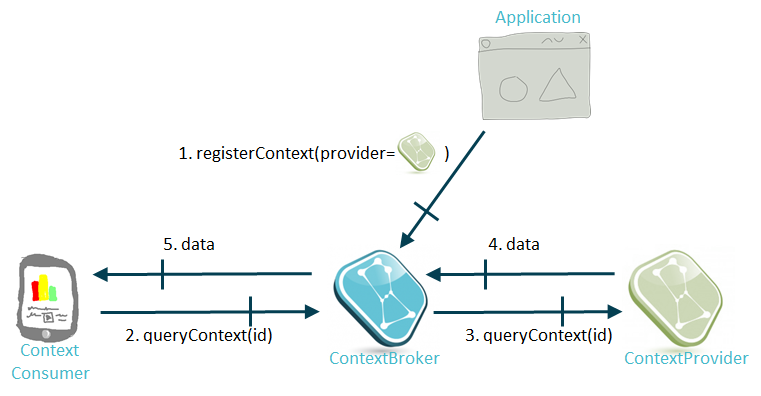Context Providers registration and request forwarding
The register context operation (both in standard and convenience cases) uses a field named "providing application" which is a URL that identifies the source of the context information for the entities/attributes included in that registration. We call that source the "Context Provider" (or CPr, for short).
...
"providingApplication" : "http://mysensors.com/Rooms"
...
If Orion receives a query or update operation (either in the standard or in the convenience family) and it cannot find the targeted context element locally (i.e. in its internal database) but a Context Provider is registered for that context element, then Orion will forward the query/update request to the Context Provider. In this case, Orion acts as a pure "NGSI proxy" (i.e. doesn't cache the result of the query internally) and, from the poinf of view of the client issuing the original request, the process is mostly transparent. The Context Provider is meant to implement the NGSI10 API (at least partially) to support the query/update operation.
Let's illustrate this with an example.

- First (message number 1), the application (maybe on behalf of a Context Provider) registers the Context Provider at Orion for the Street4 temperature. Let's assume that the Context Provider exposes its API on http://sensor48.mycity.com/ngsi10
(curl localhost:1026/v1/registry/registerContext -s -S --header 'Content-Type: application/json' --header 'Accept: application/json' -d @- | python -mjson.tool) <<EOF
{
"contextRegistrations": [
{
"entities": [
{
"type": "Street",
"isPattern": "false",
"id": "Street4"
}
],
"attributes": [
{
"name": "temperature",
"type": "float",
"isDomain": "false"
}
],
"providingApplication": "http://sensor48.mycity.com/v1"
}
],
"duration": "P1M"
}
EOF
- Next, consider that a client queries the Street4 temperature (message number 2).
(curl localhost:1026/v1/queryContext -s -S --header 'Content-Type: application/json' --header 'Accept: application/json' -d @- | python -mjson.tool) <<EOF
{
"entities": [
{
"type": "Street",
"isPattern": "false",
"id": "Street4"
}
],
"attributes": [
"temperature"
]
}
EOF
- Orion doesn't know the Street 4 temperature, but it knows (due to the registration in the previous step) that the Context Provider at http://sensor48.mycity.com/v1 knows that, so it forwards the query (message number 3) to the URL http://sensor48.mycity.com/v1/queryContext (i.e. the URL used in the Providing Application field at registration time, plus the "/queryContext" operation).
{
"entities": [
{
"type": "Street",
"isPattern": "false",
"id": "Street4"
}
],
"attributes": [
"temperature"
]
}
- The Context Provider at http://sensor48.mycity.com/ngsi10 responds with the data (message number 4).
{
"contextResponses": [
{
"contextElement": {
"attributes": [
{
"name": "temperature",
"type": "float",
"value": "16"
}
],
"id": "Street4",
"isPattern": "false",
"type": "Street"
},
"statusCode": {
"code": "200",
"reasonPhrase": "OK"
}
}
]
}
- Orion fordwars the response to the client (message number 5). Note that the response is not exactly the same, as it includes a reference to the Context Provider that has resolved it (that's why it is said that "the process is mostly transparent" instead of "the process is completely transparent"). The client can use (or ignore) that information. Orion doesn't store the Street4 temperature.
{ "contextResponses": [ { "contextElement": { "attributes": [ { "name": "temperature", "type": "float", "value": "16" } ], "id": "Street4", "isPattern": "false", "type": "Street" }, "statusCode": { "code": "200", "details": "Redirected to context provider http://sensor48.mycity.com/ngsi10", "reasonPhrase": "OK" } } ] }
The Context Providers and request forwarding functionality was developed in release 0.15.0. Previous version of Orion Context Broker just stores this field in the database. Thus, applications can access the Providing Application using the discover context availability operation and do whatever they want with it. This is typically the case when the Orion Context Broker is used just as a repository for NGSI9 registrations, but the actual management of context information is done by other components of the architecture. Although current versions support Context Providers and request forwarding functionaly, nothing precludes you from using Orion also in that way.
Some additional comments:
- The "-httpTimeout" CLI parameter is used to set the CPr timeout. If a request forwarded to a CPr is taking more that that timeout, then Orion closes the connection and assumes that the CPr is not responding.
- In the case a given request involves more than one Context Provider (e.g. an updateContext including 3 context elements, each one being an entity managed by a different Context Provider), Orion will forward the corresponding "piece" of the request to each Context Provider, gathering all the results before responding to the client. Current implementation process multiple forwards in sequence, i.e. waiting the response from a given CPr (or timeout expiration) before sending the forward request to the following.